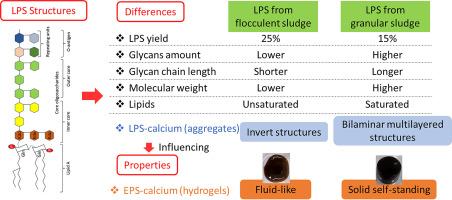当前位置:
X-MOL 学术
›
Water Res.
›
论文详情
Our official English website, www.x-mol.net, welcomes your
feedback! (Note: you will need to create a separate account there.)
Understanding the ionic hydrogel-forming property of extracellular polymeric substances: Differences in lipopolysaccharides between flocculent and granular sludge
Water Research ( IF 11.4 ) Pub Date : 2024-10-28 , DOI: 10.1016/j.watres.2024.122707 Ji Li, Xiaodi Hao, Mark C.M. van Loosdrecht, Yuemei Lin
Water Research ( IF 11.4 ) Pub Date : 2024-10-28 , DOI: 10.1016/j.watres.2024.122707 Ji Li, Xiaodi Hao, Mark C.M. van Loosdrecht, Yuemei Lin

|
An interesting and potential property of extracellular polymeric substances (EPS) is the hydrogel formation with calcium ions. Aiming at understanding the significant difference in the hydrogel formed between EPS from flocculent and granular sludge, a targeted investigation of the lipopolysaccharides (LPS), one of the important EPS components, was performed. LPS was isolated from the EPS of flocculent and granular sludge, and both the glycan and the lipid A parts of LPS were characterized and compared. The morphology of LPS-calcium (LPS-Ca) aggregates were visualized by the polymyxin B-based fluorescent probe. The LPS constituted about 25 % and 15 % of the EPS from flocculent and granular sludge, respectively. The flocculent sludge LPS showed a lower amount of glycans, shorter glycan chain length, lower molecular weight, and higher possibility of containing unsaturated lipids than the granular sludge EPS. The flocculent sludge LPS-Ca aggregates demonstrated invert structures with the water phase in between, contributing to the fluid-like property of the respect EPS-Ca. In contrast, with the remarkably different chemical structure, LPS-Ca aggregates from granular sludge displayed bilaminar multilayered morphology, contributing to the solid, self-standing hydrogel of EPS-Ca.
中文翻译:

了解细胞外聚合物物质的离子水凝胶形成特性:絮状污泥和颗粒污泥之间脂多糖的差异
细胞外聚合物物质 (EPS) 的一个有趣且潜在的特性是与钙离子形成水凝胶。为了了解 EPS 从絮状污泥和颗粒污泥中形成的水凝胶的显着差异,对 EPS 的重要成分之一脂多糖 (LPS) 进行了有针对性的研究。从絮状和颗粒状污泥的 EPS 中分离 LPS,对 LPS 的聚糖和脂质 A 部分进行表征和比较。LPS-钙 (LPS-Ca) 聚集体的形态通过基于多粘菌素 B 的荧光探针进行可视化。LPS 分别占絮状和颗粒污泥 EPS 的 25% 和 15%。与颗粒污泥 EPS 相比,絮状污泥 LPS 的游离寡糖量较低,游离寡糖链长度较短,分子量较低,含有不饱和脂质的可能性更高。絮状污泥 LPS-Ca 骨料表现出反转结构,两者之间有水相,有助于 EPS-Ca 的流体状特性。相比之下,由于化学结构明显不同,来自颗粒污泥的 LPS-Ca 聚集体呈现双层多层形态,有助于 EPS-Ca 形成固体、自立式水凝胶。
更新日期:2024-10-31
中文翻译:

了解细胞外聚合物物质的离子水凝胶形成特性:絮状污泥和颗粒污泥之间脂多糖的差异
细胞外聚合物物质 (EPS) 的一个有趣且潜在的特性是与钙离子形成水凝胶。为了了解 EPS 从絮状污泥和颗粒污泥中形成的水凝胶的显着差异,对 EPS 的重要成分之一脂多糖 (LPS) 进行了有针对性的研究。从絮状和颗粒状污泥的 EPS 中分离 LPS,对 LPS 的聚糖和脂质 A 部分进行表征和比较。LPS-钙 (LPS-Ca) 聚集体的形态通过基于多粘菌素 B 的荧光探针进行可视化。LPS 分别占絮状和颗粒污泥 EPS 的 25% 和 15%。与颗粒污泥 EPS 相比,絮状污泥 LPS 的游离寡糖量较低,游离寡糖链长度较短,分子量较低,含有不饱和脂质的可能性更高。絮状污泥 LPS-Ca 骨料表现出反转结构,两者之间有水相,有助于 EPS-Ca 的流体状特性。相比之下,由于化学结构明显不同,来自颗粒污泥的 LPS-Ca 聚集体呈现双层多层形态,有助于 EPS-Ca 形成固体、自立式水凝胶。


















































 京公网安备 11010802027423号
京公网安备 11010802027423号